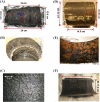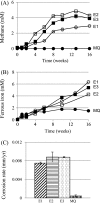Effect of sodium bisulfite injection on the microbial community composition in a brackish-water-transporting pipeline
- PMID: 21856836
- PMCID: PMC3187121
- DOI: 10.1128/AEM.05891-11
Effect of sodium bisulfite injection on the microbial community composition in a brackish-water-transporting pipeline
Abstract
Pipelines transporting brackish subsurface water, used in the production of bitumen by steam-assisted gravity drainage, are subject to frequent corrosion failures despite the addition of the oxygen scavenger sodium bisulfite (SBS). Pyrosequencing of 16S rRNA genes was used to determine the microbial community composition for planktonic samples of transported water and for sessile samples of pipe-associated solids (PAS) scraped from pipeline cutouts representing corrosion failures. These were obtained from upstream (PAS-616P) and downstream (PAS-821TP and PAS-821LP, collected under rapid-flow and stagnant conditions, respectively) of the SBS injection point. Most transported water samples had a large fraction (1.8% to 97% of pyrosequencing reads) of Pseudomonas not found in sessile pipe samples. The sessile population of PAS-616P had methanogens (Methanobacteriaceae) as the main (56%) community component, whereas Deltaproteobacteria of the genera Desulfomicrobium and Desulfocapsa were not detected. In contrast, PAS-821TP and PAS-821LP had lower fractions (41% and 0.6%) of Methanobacteriaceae archaea but increased fractions of sulfate-reducing Desulfomicrobium (18% and 48%) and of bisulfite-disproportionating Desulfocapsa (35% and 22%) bacteria. Hence, SBS injection strongly changed the sessile microbial community populations. X-ray diffraction analysis of pipeline scale indicated that iron carbonate was present both upstream and downstream, whereas iron sulfide and sulfur were found only downstream of the SBS injection point, suggesting a contribution of the bisulfite-disproportionating and sulfate-reducing bacteria in the scale to iron corrosion. Incubation of iron coupons with pipeline waters indicated iron corrosion coupled to the formation of methane. Hence, both methanogenic and sulfidogenic microbial communities contributed to corrosion of pipelines transporting these brackish waters.
Figures





References
-
- Bak F., Cypionka H. 1987. A novel type of energy metabolism involving fermentation of inorganic sulfur compounds. Nature 326:891–892 - PubMed
-
- Bak F., Pfennig N. 1987. Chemolithotrophic growth of Desulfovibrio sulfodismutans sp. nov. by disproportionation of inorganic sulfur compounds. Arch. Microbiol. 147:184–189
-
- Bødtker G., Lysnes K., Torsvik T., Bjørnestad EØ., Sunde E. 2009. Microbial analysis of backflowed injection water from a nitrate-treated North Sea oil reservoir. J. Ind. Microbiol. Biotechnol. 36:439–450 - PubMed
-
- Borg I., Groenen P. 2010. Modern multidimensional scaling: theory and applications. Springer, New York, NY
Publication types
MeSH terms
Substances
Associated data
- Actions
LinkOut - more resources
Full Text Sources

